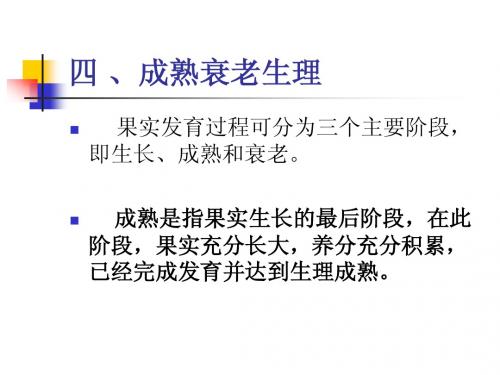第四章 果蔬成熟衰老生理
四 、成熟衰老生理

果实发育过程可分为三个主要阶段, 即生长、成熟和衰老。
成熟是指果实生长的最后阶段,在此 阶段,果实充分长大,养分充分积累, 已经完成发育并达到生理成熟。
完熟是指果实达到成熟以后,即果实成 熟的后期,果实表现出特有的颜色、风 味、质地,达到最佳食用阶段。
后熟通常是指果实离开植株后的成熟现 象 .
果蔬的衰老简单的说是当它的个体发育 进入最后阶段时,开始发生一系列不可 逆的变化,最终导致细胞崩溃及整个器 官死亡的过程。
(一)成熟与衰老的机制
(1)不同激素的作用 不同种类的激素对果实成熟的作用 不同。生长素、细胞分裂素和赤霉素有 延迟果实成熟和衰老的作用。脱落酸对 果实的成熟起非常重要的促进作用。
④尽量降低贮藏温度,因为低温也可以 抑制乙烯的生成及乙烯的生理活性。
⑤、排除或吸收贮藏环境中的乙烯
a 通风排除乙烯 必须及时排除贮藏环境中的乙烯, 排除乙烯的最简单方法是通风换气,冷 藏和通风贮藏库可以开门或通风排除乙 稀。
B 乙烯吸收剂脱除乙烯
目前生产上常用的乙烯吸收剂是高锰酸钾, 具体做法是将高锰酸钾配成饱和溶液,用一些多 孔、多面的珍珠岩、砖块作为高锰酸钾的载体, 将它们放入饱和高锰酸钾溶液中浸透,自然晾干 后,装入塑料袋中密封,使用时再放入打孔的小 薄膜塑料袋中,也可用纱布包成小包放在气调贮 藏库或塑料袋及塑料帐中,乙烯将被吸附氧化, 当高锰酸钾失效时,颜色会由原来的紫红色变成 砖红色,此时应及时更换。此法使用方便,价格 低廉,高锰酸钾乙烯吸收剂现用现配制效果更好。 此外,也可以用溴化物制成乙烯氧化剂,焦碳分 子筛对乙烯也有一定的吸附能力。
第四章 果蔬成熟衰老生理

编辑版pppt
25
MATURITY INDICES 成熟指标
编辑版pppt
28
• In practice, any analytical or physical measurement that changes with physiological development and relates to customer acceptance has potential as a
• Commonly selected factors reflecting horticultural maturity include firmness, skin color, flesh color, sugar content, soluble solids, acid content, and pigments. Days from full bloom (Fig. 2) and heat unit accumulation (Table 4, Peas ) during specific periods during the growing season are also used .
4
• Watada等把成熟定义为:果实达到生理学 和园艺学成熟度的一个发育阶段;完熟则 定义为:生长发育末期即衰老早期所发生 的、导致果实美学特性或食用品质变化的 一系列事件。
编辑版pppt
5
These trends represent the generalised behaviour of fruit maturation with relative accuracy
成熟与衰老

成熟与衰老1.1 果蔬成熟与衰老的相关概念(1)生理成熟(maturation)果实生长的最后阶段,在此阶段,果实完成了细胞、组织、器官分化发育的最后阶段,充分长成时,达到生理成熟,也称为“绿熟”或“初熟”。
(2)完熟(ripening)果实停止生长后还要进行一系列生物化学变化逐渐形成本产品固有的色、香、味和质地特征,然后达到最佳的食用阶段。
☐通常将果实达到生理成熟到完熟过程都叫成熟。
☐生理成熟是完熟的前提。
(3)后熟(post-maturation)果实采收后呈现特有的色、香、味的成熟过程。
达到食用标准的完熟可以发生在植株上,也可以发生采后,但是后熟仅指采后的。
(4)衰老(senescence)果实中最佳食用阶段以后的品质劣变或组织崩溃称为衰老。
1.2 成熟和衰老期间的变化(1)叶柄和果柄的脱落(2)颜色的变化(3)组织变软、发糠(4)种子及休眠芽的长大(5)风味变化(6)萎蔫(7)果实软化(果胶降解)(8)细胞膜变化(透性增强)(9)病菌感染1.3 成熟与衰老的机制果蔬在生长、成熟、衰老过程中,生长素、赤霉素、细胞分裂素、脱落酸、乙烯五大植物激素的含量有规律地增长和减少,保持一种自然平衡状态,控制果蔬的成熟与衰老。
☐生长素、赤霉素和细胞分裂素——生长激素,抑制果实的成熟与衰老;☐脱落酸和乙烯——衰老激素,促进果蔬的成熟与衰老。
乙烯与果蔬成熟衰老的关系☐乙烯是对果蔬成熟作用最大的植物激素。
☐果蔬乙烯的合成受基因控制。
(1)乙烯的生物合成(2)影响乙烯生物合成的因素①果实成熟度不同成熟阶段的组织对乙烯作用的敏感性不同,跃变型果实在跃变前对乙烯不敏感,随着果实的发育,组织对乙烯的敏感性不断上升,基础乙烯的积累会导致成熟的启动和乙烯的自我催化。
故长期贮藏的产品要在跃变之前采收。
②伤害胁迫因素包括机械损伤、高温、低温、病虫害、化学物质等,逆境因子提高ACC合成酶的活性,促进乙烯的合成。
③贮藏温度乙烯的合成是一个酶促反应,一定范围内的低温贮藏可以大大降低乙烯的合成。
四 、成熟衰老生理

①合理选果 贮藏前将有病虫和机械伤的果蔬挑 出,因为病害虫侵染和伤口都会刺激果 蔬生产乙烯,在果蔬的采收、分级、包 装、运输和销售中要轻拿轻放、避免产 品损伤。
②不混果贮藏
③控制贮藏环境条件,抑制乙烯的生成 和作用 a 降低氧气的浓度,可抵制乙烯的 生物合成,提高二氧化碳的浓度可以通 过与乙烯竞争受体来抵制乙烯的生理作 用。
2.化学药剂的应用
3.物理技术的应用
?b乙烯吸收剂脱除乙烯?目前生产上常用的乙烯吸收剂是高锰酸钾具体做法是将高锰酸钾配成饱和溶液用一些多孔多面的珍珠岩砖块作为高锰酸钾的载体将它们放入饱和高锰酸钾溶液中浸透自然晾干后装入塑料袋中密封使用时再放入打孔的小薄膜塑料袋中也可用纱布包成小包放在气调贮薄膜塑料袋中也可用纱布包成小包放在气调贮藏库或塑料袋及塑料帐中乙烯将被吸附氧化当高锰酸钾失效时颜色会由原来的紫红色变成砖红色此时现在有很多证据表明,乙烯是事实上 的催熟剂,对成熟过程也有刺激作用。 在生产上,已广泛用于果蔬的催熟。 许多研究证实乙烯能刺激呼吸跃变 型果实的跃变期提前出现。
成熟衰老控制 在果蔬贮运过程中,一般是通过控制由 温度、相对湿度、空气成分三要素组成 的综合环境,采用一些辅助性处理措施 来控制果蔬体内的物质转化和乙烯的合 成,达到控制果蔬成熟与衰老的目的。
(3)气体组成 在一定范围内,降低O2浓度、升高CO2浓 度都有抑制果蔬呼吸,延缓后熟老化过程等作 用。同时控制O2和CO2两者的含量,可以获得 更好的效果。控制适当的气体组成,即使温度 较高,也有比较明显的减少损耗、延缓衰老、 延长贮期的效果。若同时控制贮藏温度,则能 获得更好的延缓成熟衰老的效果。
果蔬的衰老简单的说是当它的个体发育 进入最后阶段时,开始发生一系列不可 逆的变化,最终导致细胞崩溃及整个器 官死亡的过程。
Chapter4园艺产品成熟、衰老及调控

番茄、甜瓜、甜玉米。
第一节 园艺产品成熟与衰老
二 成熟和衰老期间果蔬的变化 (三)口感风味变化
涩味: 柿、梨、苹果未熟有涩味,成熟后涩味消失。 酸味: 通常果实发育完成后含酸量最高,贮藏后逐 渐下降。 柠檬
另未熟果实,含酸量较高,随着果实的成熟,酸度下 降,甜度增加。
第一节 园艺产品成熟与衰老
细胞壁的主 要组分:
纤维素 半纤维素 果胶 蛋白质
第四章 果蔬成熟、衰老及调控
第一节 园艺产品成熟与衰老 第二节 乙烯与园艺产品的成熟及衰老
第二节 贮藏实践中对果蔬成熟衰老控制
第二节 乙烯与园艺产品成熟与衰老
乙烯(ethylene)是影响呼吸作用的重要因素。 通过抑制或促进乙烯的产生,可调节果蔬的成熟 进程,影响贮藏寿命。
熟或生理成熟。 即指果实生长的最后阶段,在此阶段,果实
充分长大,养分充分积累,已完成发育并达到生 理成熟的程度。→完熟。
第一节 园艺产品成熟与衰老
一 成熟与衰老的概念 完熟(ripening):
指果实达到成熟以后,即果实成熟后期,果 实内发生一系列急剧的生理生化变化,色、香、 味、质地达到最适于食用的阶段。
第四章 果蔬成熟、衰老及调控
第一节 园艺产品成熟与衰老 第二节 乙烯与园艺产品的成熟及衰老 第三节 贮藏实践中对果蔬成熟衰老控制
第一节 园艺产品成熟与衰老
一 成熟与衰老的概念 生活有机体生命过程中的两个阶段:
1 成熟(maturation):
果实从开花受精后,完成了细胞、组织、器 官分化发育的最后阶段,充分长成时,通常称成
感染等逆境时,内源乙烯含量可提高3-10倍。
果蔬衰老机理研究简述

果蔬衰老机理研究简述
果蔬衰老机理研究简述
果蔬衰老是指果蔬在生长、采样、运输及储藏等过程中,由于受温度、湿度等环境因素的影响,导致生物物质的逐渐降解和变质,从而使其品质及营养价值降低,这称为果蔬衰老。
果蔬衰老的主要机理可以分为以下几类:
1. 酶解机制:
衰老是由于果蔬内部酶活性的升高而导致的,这些酶能够降解果蔬中的蛋白质、糖分和油脂等物质,从而导致果蔬品质的变化。
2. 生物化学反应:
果蔬衰老还可以受到生物化学反应的影响,例如,脯氨酸氧化和非酶氧化,这些化学反应导致果蔬中的某些物质被氧化,从而影响果蔬品质。
3. 生理变化:
在果蔬衰老过程中,果蔬中的物理特性也会发生微小的变化,例如质量和含水率的变化,这些变化会对果蔬的口感和外观产生显著影响。
4. 微生物传播:
果蔬衰老还可以是由于微生物的侵染,例如细菌和真菌,这些微生物可以分解果蔬中的有机物质,从而影响果蔬的品质。
总之,果蔬衰老是复杂的,由多种机理共同作用而产生的,果蔬衰老的机理研究可以为果蔬加工及储藏过程提供理论依据,提高果蔬
质量和口感。
植物生理学成熟和衰老生理课件

植物生理学成熟和衰老生理课件
三、外界条件对种子成熟和化学成分的影响
• 1. 光照
光照强,叶片同化物多,输入到籽粒的多,产量 高;
➢非骤变型果实的乙烯生成速率相对较低, 变化平稳,整个成熟过程中只有系统Ⅰ活 动,缺乏系统Ⅱ。
植物生理学成熟和衰老生理课件
➢对于骤变型果实,外源乙烯只在跃变前起 作用,它能诱导呼吸上升,同时促进内源 乙烯的大量增加,即启动系统Ⅱ,形成了 乙烯自我催化作用,且与所用的乙烯浓度 关系不大,是不可逆作用。
• 2.温度
• 温度过高呼吸消耗大,籽粒不饱满;温度过低不利于有机 物质运输与转化,种子瘦小,成熟推迟。
• 油料种子的成分受温度影响较大:温度较低、昼夜温差大,
含油量和不饱和脂肪酸含量高,蛋白质含量较低(北方的
油脂品质好);
植物生理学成熟和衰老生理课件
3.空气相对湿度 大气干旱,影响淀粉累积,种子瘦小、
➢ 天然单性结实:指不需要经过受精作用或其他刺激诱导而 结实的现象。同一种植物,无种子的子房中生长素含量较有种子的
为高。
➢ 刺激性单性结实:也称诱导性单性结实。在外界环境条件 的刺激下而引起的单性结实。
• 原因: 果实生长与受精后子房生长素含量增多有关。
➢ 植物完成了受精作用,但由于种种原因,胚的发育中止, 而子房或花的其他部分继续发育,也可成为没有种子的果 实。这种现象称为假单性结实。
植物生理学成熟和衰老生理课件
1.淀粉的合成与 积累
➢ 合成淀粉的场所是 淀粉体.
果蔬衰老机理研究简述

果蔬衰老机理研究简述
x
果蔬衰老机理研究简述
果蔬衰老是指果蔬受到各种外界因素的影响而丧失其生物功能
造成的质量变化。
它是果蔬的自然老化过程,包括贮藏过程中的生理衰老和病害发生过程中的病理衰老。
果蔬衰老的机理主要有温度、水分、氧气、光照和化学因素等。
其中,温度和水分是影响衰老的最主要因素,它们影响果蔬细胞膜的稳定性,影响果蔬氧化还原反应及果糖代谢的稳定性,进而影响果蔬的品质和外观。
氧气则会影响果蔬的抗氧化系统,若氧气过多,会造成果蔬发生氧化反应,导致发黄、发绿等衰老症状的出现,反之,氧气过少会造成植物细胞呼吸缺氧,影响果蔬的生长发育等。
此外,光照也是一个重要因素,它可以促进果蔬生长,也可以导致果蔬的光变质现象。
最后,化学因素也会影响果蔬衰老,具体表现为污染物的残留、病虫害发生的时间、强度、种类等,都会导致果蔬衰老。
总体而言,果蔬衰老是多种因素共同作用的结果,而其中以温度和水分为主要影响因素。
正确的温度和水分管理可以控制果蔬衰老,减少果蔬的衰老和损坏,提高贮藏效果,有效改善果蔬的质量和保鲜能力。
- 1、下载文档前请自行甄别文档内容的完整性,平台不提供额外的编辑、内容补充、找答案等附加服务。
- 2、"仅部分预览"的文档,不可在线预览部分如存在完整性等问题,可反馈申请退款(可完整预览的文档不适用该条件!)。
- 3、如文档侵犯您的权益,请联系客服反馈,我们会尽快为您处理(人工客服工作时间:9:00-18:30)。
综合
• Fruits can be divided into two groups:1)fruits that are not capable of continuing their ripening process once removed from the plant, and 2)fruits that can be harvested mature and ripened off the plant.
• Maturation at harvest is the most important factor that determines storage-life and final fruit quality.
• Ripening is the composite of the processes that occur from the latter stages of growth and development through the early stages of senescence and that results in characteristic aesthetic美学的 and/or food quality, as evidenced by /iːs`θetɪk/ changes in composition, colour, texture, or other sensory attributes.
• The complexities of maturity definition have resulted in the development of a number of maturity indices that attempt to relate a chemical or physical measurement to the commercial maturity of the particular commodity. • The intention is that these indices will reflect or predict the quality or quality grade of the commodity received by the customer.
• Fruit and vegetable development starts with formation of an edible part—fruit 座果 setting, seedling emergence, tuber 出苗 development, or stalk development—and ends with loss of edible character through physiological deterioration, development of fibrous character, or spoilage through microbiological intervention.
• The maturity index should be easily determined, use simple equipment, and provide good correlation with efficacy in final use. /`efɪkəsi/
成熟度指数
Maturity indices include color, juice content, level of soluble solid ...
MATURITY INDICES 成熟指标
• Commonly selected factors reflecting horticultural maturity include firmness, skin color, flesh color, sugar content, soluble solids, acid content, and pigments. Days from full bloom (Fig. 2) and heat unit accumulation (Table 4, Peas ) during specific periods during the growing season are also used .
• In practice, any analytical or physical measurement that changes with physiological development and relates to customer acceptance has potential as a 成熟度指数 maturity index, and the use of sensory panels to demonstrate this relationship is a fairly recent development.
In the diagram above on the left is an unripe fruit. It is hard, green, sour, has no smell, is mealy (starch present), and so on.
• 衰老senescence 是指果实生长已经停止, 完熟变化基本结束后进入的时期。Watada 把衰老定义为:随着生理学或园艺学成熟 度增加而导致组织死亡的过程。 • Senescence or biological aging is the change in the biology of an organism as it ages after its maturity.
果胶酶合成 类胡萝卜素合成 蔗糖合成或糖的转化 芳香物质的合成 乙烯合成
淀粉水解
• 1、正如一切生物体终不免进入衰老和死亡 一样,果实最后也从成长转入衰老。 • 2、果实成熟是由激素控制的,其中最重要 的是乙烯。 • 3、成熟过程是不可逆的。 • 4、果实在成熟过程中,物质的合成和降解 过程同时进行。 • 5、果实的成熟是一个需能过程。
第四章 果蔬成熟衰老生理
第一节 成熟与衰老的概念
一、成熟与衰老的几个概念 • 成熟和衰老是有机体生命活动过程中的两 个阶段。 • 成熟在词典中的解释是指达到完成生物某 系统的代表性阶段的状态。如植物的果实 或谷物生长到可收获的程度。
• 在英文中,maturation,ripening 都可翻译 为成熟。但二者在程度上有实质性的差异。 • Maturation /`mætʃu`reɪʃn/ :是指果实最后达 到充分大小可以采摘(但不一定是食用品 质最佳)的过程,也可以称为初熟或可采 成熟度;
坚实度
• Firmness is a well recognized maturity index (Figs. 3A and 3B) and is commonly measured with a penetrometer, an 针入度仪 instrument that determines the force required to push a probe of known diameter through the flesh of the fruit or vegetable.
• 成熟与完熟是两个不同质的生育过程。在 成熟后期,果实一面继续成熟,一面深化 而开始完熟进程。这里的成熟过程是指果 实停止生长之后进行的一系列生物化学变 化,即从maturation 向 ripening 阶段转化 的过程。
maturation → ripening
INTRODUCTION to Fruit development
• There are a number of theories why senescence occurs including those that it is programmed by gene expression changes and that it is the accumulative damage of biological processes.
• Ripening熟成\完熟 :则指果实经过一系列 质变,达到完全可以食用的阶段,一般将 其称为“完熟”或“鲜食成熟度”。 • Ripening is a process in fruits that causes them to become more edible. In general, a fruit becomes sweeter, less green, and softer as it ripens.
二、果实成熟的特征 • 不同果实的具体成熟过程是不相同的,但 它们也有共同的特征(表4-1)。
生物合成
生物降解
RNA转录、复制,蛋白质合成 脂肪、蛋白质分解,生物膜 透性增加 成熟过程中所需酶的合成 叶绿体解体 植物膜结构的维持 有机酸转化分解 线粒体结构的维持 基质氧化和ATP利用 EMP、TCA循环、HMP活性增 可溶性果胶增加 加 ATP合成 叶绿素分解
• Watada等把成熟定义为:果实达到生理学 和园艺学成熟度的一个发育阶段;完熟则 定义为:生长发育末期即衰老早期所发生 的、导致果实美学特性或食用品质变化的 一系列事件。
These trends represent the generalised behaviour of fruit maturation with relative accuracy
• Maturation is the stage of development leading to the attainment of physiological or horticultural maturity. 生理成熟度 • Physiological maturity is the stage of development when a plant or plant part will continue ontogeny even if detached. 分离 个体发育 • Horticultural maturity is the stage of 园艺成熟度 development when a plant or plant part possesses the prerequisites for utilisation by consumers for a particular purpose.
